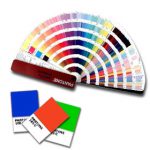Defining our business helps our customers to fully understand what we do.
While our FAQ pages contain many questions, we thought about getting down to the nitty-gritty for you. Here is part two of our definitions series. Find out more about how our business runs! While our Artwork Guide features most of this topic, there might still be a few unanswered questions.
Our artwork guide says the following:
Imprinted Ribbons require black and white, one color vector art. Full Color Ribbons may be created using vector art or high quality bitmap files (300 dpi minimum). High quality artwork is required for all processes. Unfortunately, we cannot consider faxes, photocopies, business cards, printed products or photos of any of the above to be print-ready artwork. We can quote most jobs by using such artwork, but we cannot use this art for production.
To help you understand better what we need for your artwork, here are the definitions to the files we accept for production.
 Vector Artwork
Vector Artwork
For the best results, we recommend submitting all artwork as vector files (.eps, .ai,.cdr ) with all text converted to curves or outlines. Vector art means the computer mathematically plots the outline of each shape and applies a fill color. The computer knows exactly what shapes are in the image. If you zoom in on a vector file the colors remain clear and the edges are clean and well defined.
 Bitmap Artwork
Bitmap Artwork
The quality of your printed ribbons depends on the quality of the artwork submitted. Bitmap art uses a grid of tiny squares of color (pixels) to create the image. The computer will not know what shape is in the image because it does not recognize color differences in pixels. This is also known as raster artwork. An image from the internet (usually a .jpg, .png, or .gif saved at a resolution of 72 dpi) that looks great on your monitor will not print well. When you zoom in on a low-quality bitmap image you will see squares, rough edges and uneven colors. You cannot improve the quality of the image simply by saving it with higher dpi settings. The image will have more dots per inch, but the quality will remain the same or even degrade further.
 Color Matching
Color Matching
The best way to let us know what colors you expect is the Pantone Matching System (PMS). We make reasonable efforts to match these colors however, we do not offer exact color matches due to limitations of the production processes. Available materials limit the color of imprinted logos and surfaces. Variations in materials, printer ribbons, equipment, and environmental factors preclude any guarantee of color. If color matches are important, we recommend the purchase of a First Article; we may send a color sample in some circumstances. However, variations in materials, stamping foils, printer ribbons, equipment, and environmental factors preclude any guarantee of exact color consistency from lot to lot or even item to item within the same lot.
Do you have any further questions about these definitions?
There will be more articles coming with even more definitions! Please help us by letting us know what definitions you need. Are there specific things you just don’t quite understand? Reply with anything that you might need help with!
